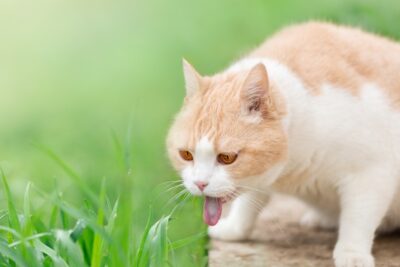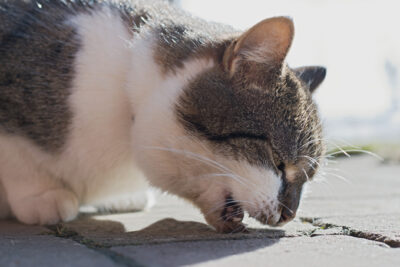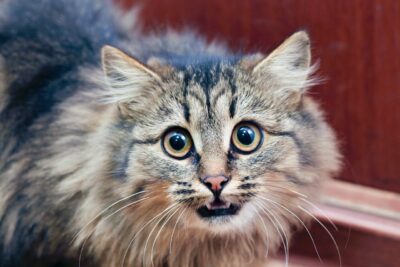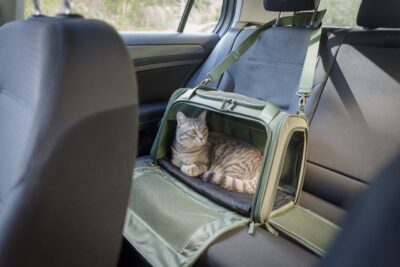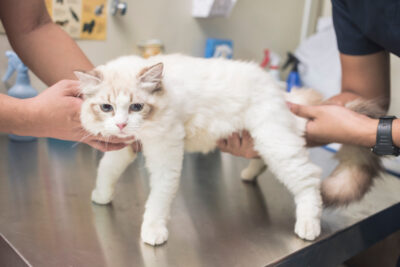How Hot Is Too Hot for Cats?

Picture a lazy Sunday in the winter when your cat is snuggled in a blanket right next to the fireplace. Now picture a lazy Sunday in the summer when your cat is sunbathing in 80-degree heat.
Cats seem to love heat, but is it possible to have too much warmth? How hot is too hot for cats?
While overheating in cats is uncommon, it is a very serious condition and all pet parents should know what to watch for, and how to prevent it.
What Temperature is Too Hot for Cats?
There is no simple answer to this question! Each cat will have a temperature that is too hot for him or her as an individual – depending on their age, health, fur coat, or what environment they are used to.
Cats naturally relieve heat from their body through changes to their blood vessels during high temperatures, choosing a cool surface to lie on, avoiding direct sunlight, and seeking air flow like a gentle breeze.
However, as environmental temperatures reach close to their body’s natural temperature, cats become too hot. Normal body temperature for a cat older than 4 weeks old is 99.5 to 102.5 degrees. Temperatures around 90 degrees and above tend to make cats uncomfortable and lead to the need for additional heat loss through panting.
Humidity is the measure of how much water is in the air. As humidity increases, it decreases the amount of heat that can leave the surface of the body. If humidity is high, the temperature does not need to be very hot outside before it is too hot for cats.
The American Veterinary Medical Association recommends maintaining places where cats and dogs live to under 80 degrees, and 30 to 70 percent relative humidity [1]. Federal Animal Welfare Regulations, maintained by the United States Department of Agriculture, require no more than 4 hours of exposure to temperatures over 85 degrees for cats and dogs [2]. Both of these organizations set limits that should maintain the comfort of most animals, but keep in mind that some animals will not be comfortable even when following these guidelines.
Do Cats Get Hot?

Cats definitely get hot. Their comfort level tends to be higher than it is for humans, as most people do not appreciate 90-degree weather. Cats that are uncomfortable with the temperature seek a cooler surface to lay on, avoid direct sunlight or sources of heat, and avoid exercise.
When cats become very uncomfortable, you will notice panting which is otherwise uncommon in cats. Your cat may not wish to eat as much and will be much less active. If this occurs, you should provide plenty of fresh water and shelter from the heat immediately.
Short exposure to high temperatures is easier to handle. The higher the temperature gets, the shorter your cat can withstand the heat. If temperatures are around 85 to 90 degrees, your cat may be comfortable for a couple hours if there is an opportunity to cool herself and get plenty of water. If temperatures are well above 90 degrees, it’s a good guess that your cat will be hot within a matter of minutes as opposed to hours – even if water and shade are available.
What Temperature Do Cats Like?
In general, cats are most comfortable above 60 degrees and below 80 degrees. However, this depends heavily on the individual cat, the humidity in the air, the ability to rest on a cool surface, and how well ventilated a space is.
Humidity under 70 percent is most comfortable. The higher the humidity, the quicker your cat becomes uncomfortable in any temperature. Air conditioning decreases humidity, but dehumidifiers can be used as well.
Most homes can easily provide cool surfaces. These are not surfaces that are cooled purposefully – cold surfaces are rarely comfortable for cats – but are areas of the home where sunlight is blocked, and the material does not easily absorb heat. Most types of flooring inside a home stay cool, especially hard surfaces like tile.
Ventilation is important when heat rises. Any flow of air will help cats dispel heat from the body such as a fan or opening windows or screen doors to catch a breeze. (Always ensure intact screens cover the openings to keep your cat from getting out!) If cats are trapped in a small room without any fresh flow of air such as an attic space, the heat rises quickly and can cause your cat to overheat.
Can Cats Overheat?

Cats can overheat, but it is rare. For this reason, it is not well studied in cats. In contrast, overheating is fairly common in dogs. One study in the United Kingdom showed that all cats with heat-related illness became ill due to high environmental temperatures, and not from too much exercise, which was common in dogs [3]. Cats are known to climb into clothes dryers and may develop heat stroke if they remain in the dryer after it is turned on [4].
When cats overheat, it causes heat stroke. Heat stroke is life-threatening and is caused by high body temperatures leading to damage to multiple organs in the body.
There are several reasons an individual cat may be more likely to overheat such as:
- Obesity
- Heart disease
- Old age
- Dark-colored coat
- Brachycephalic breed (ex. Persians)
- Hyperthyroidism (producing too much thyroid hormone)
- History of seizures
- Medications such as furosemide or beta blockers (ex. atenolol)
- Recently gave birth and has low calcium levels
Cats need to acclimatize or get used to the environmental temperatures. This process takes 60 days and occurs naturally as seasons change and temperatures rise. Physiologic properties within your cat’s body change, like how much water and salt the body holds on to (as opposed to letting it leave through urine) and how much blood the heart pumps out. For this reason, cats that move from a cooler climate to a hot climate and cats who are exposed to sudden high temperatures when spring turns to summer are more at risk of overheating.
Outdoor and indoor cats are both at risk of overheating. Outdoor cats that are not confined are likely to have acclimatized to the outdoor temperatures and have favored spots to keep cool. However, if water becomes scarce and temperatures soar, outdoor cats can overheat. Indoor cats tend to get overheated when they are confined in a small hot space like an attic, small unventilated room, or clothes dryer.
Signs a Cat is Overheating
If your cat appears to be overheating, she should be seen by an emergency veterinarian immediately.
Symptoms of heat stroke in cats include:
- Fast breathing
- Continuous panting
- Struggling to breathe
- Excessive saliva
- Vomiting with blood
- Diarrhea with blood
- Inactive, unwilling to hardly walk
- Collapse (i.e. suddenly drops to the ground, not moving or not completely aware of her surroundings)
- Disorientation (i.e. does not appear to know where she is, spaced out, stumbling)
- Seizures
How to Cool a Cat Down

If pet parents note their cat is overheating, they should immediately use a cloth soaked in room temperature water, gently wipe the cat down with it, and place the cat in front of a fan. If the cat was on a warm or hot surface, place her on a surface that is not in direct sunlight and is cool to the touch. Call your veterinarian right after this.
If any symptoms of heat stroke appear, transport your cat to the emergency hospital right away. In the car on the way to the hospital, pet parents should turn the air conditioning on or roll the windows down for a breeze.
Pet parents should NOT use cold water on their cat, use ice packs or ice baths, cover their cat in wet towels, or place rubbing alcohol on the paws. All of these actions will either cause too fast of a drop in temperature which will worsen the cat’s condition or will actually decrease the ability of the body to get rid of excess heat.
Summer Tips for Keeping Cats Cool

If you’re trying to get through the dog days of summer with your feline friend, here are some tips to keep your cat cool and comfortable when temps heat up.
Try Frozen Treats
While frozen treats will not help cats who are overheating – or prevent them from doing so in very high temperatures – it is a great kitty enrichment tool and will cool them slightly on a warm day.
Some lickable treats can be frozen, or pet parents can purchase an ice cube tray and fill it with either low-sodium chicken broth, tuna juice, or plain water as an interesting frozen treat.
Keep Fresh Water Flowing
Keeping fresh water available to cats at all times is critical to preventing overheating. While cats do not typically drink a lot of water, high temperatures will cause them to drink more. Cat water fountains are a great way to encourage cats to stay hydrated.
During travel or any time pet parents are on-the-go, bringing a portable water bowl is a must to offer their cat something to drink at least every 4 hours in air conditioning or every hour in warm temperatures or high humidity.
Try a Cooling Mat or Bed
As mentioned, cats can rid their bodies of excess heat by lying on a cool surface. A gel-based cooling mat or bed may help to keep your cat comfortable during heat waves. Make sure to avoid products with ice packs or frozen water, as these are not ideal for regulating your cat’s body temperature.
